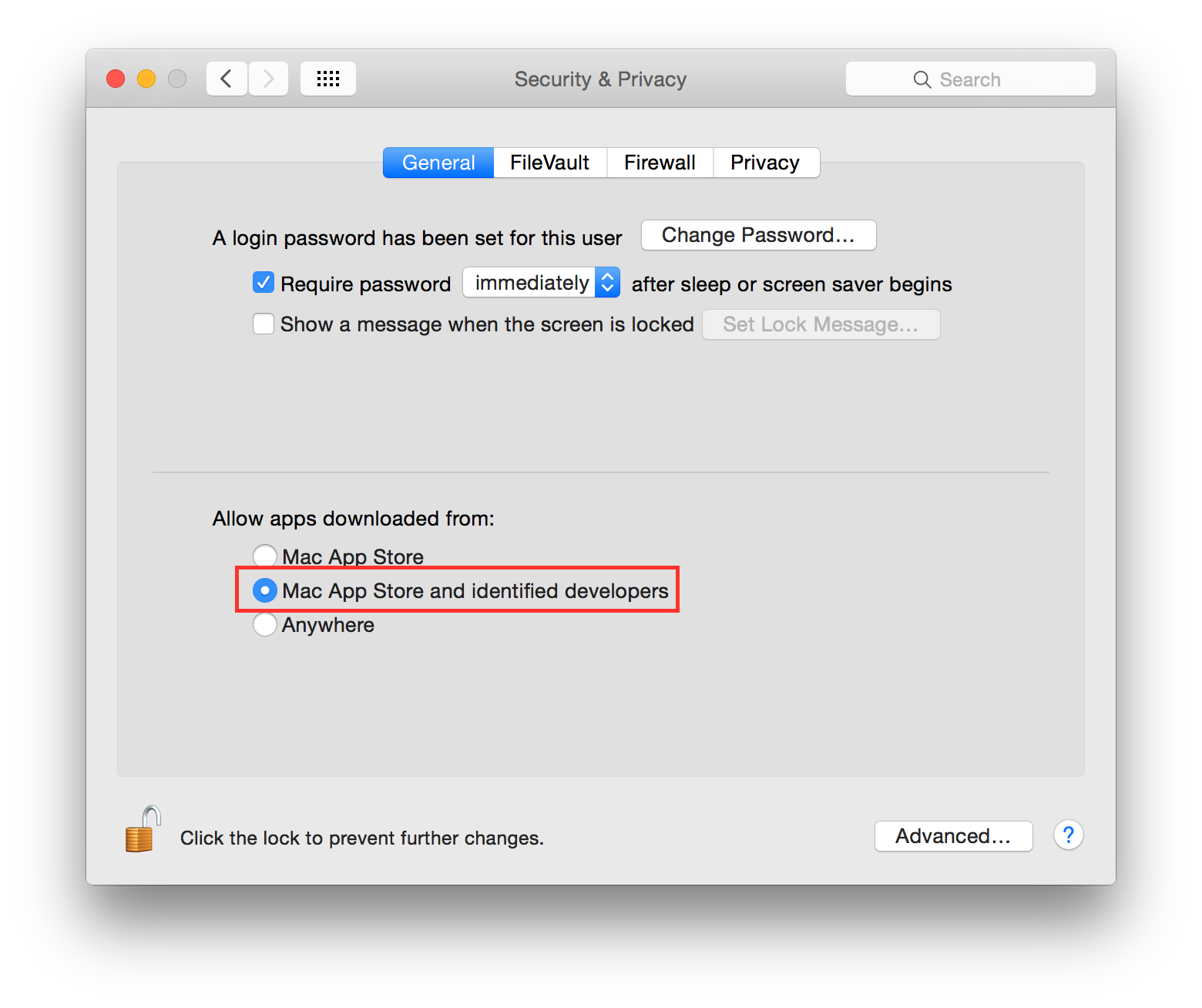- How To Change Security Preferences On Mac For Apps Windows 10
- How To Change Security Preferences For Apps On Mac
- Mac Security Settings
Changing the Security preferences for Mac OS X Snow Leopard is easy. You have options to use a firewall, enable the FileVault, and more. To access security preferences, open the System Preferences by clicking the gear icon on the dock and then choose the Security pane.
Oct 04, 2019 Warning: This terminal trick disables important security aspects of Gatekeeper, which leaves your Mac vulnerable to malware. We highly recommend you reinable the default security settings if you chose to follow this guide at your own risk.
How To Change Security Preferences On Mac For Apps Windows 10
Settings here are divided into three tabs:
General: To add an extra layer of password security to a laptop (or a Mac in a public area), select the Require Password After Sleep or Screen Saver Begins check box. Snow Leopard then requires that you enter your login password before the system returns from a sleep state or exits a screen saver. Click the pop-up delay menu to specify when the password requirement will kick in (it’s immediate by default).
This successfully blocks all traffic in the occasion that the VPN connection drops. In the past year they have updated their apps with a far better firewall-based kill button. This gives even more transmission capacity and also far better speeds for all the customers by dispersing loads effectively across the network. Download nord version 4.12.8 for mac free. While there was still some irregularity with servers I checked in the US/Canada area, I located it to be fairly simple to discover a quick server with NordVPN’s large network.The factor for the boosted performance is that NordVPN has actually added thousands of brand-new servers to their VPN network. Nord VPN 6.18.9.0 Download for WindowsIn regards to safety and security, NordVPN likewise does effectively.
» » Earth 3D Earth 3DLiterally take a tour around the world in this 3D animated screensaver. The screensaver adheres to the day/night cycle and features a starry sky along with the actual phases of the Sun and Moon. It shows you lots of information about planet Earth while the camera rotates around it, from the names of the various countries, cities and seas to the Wonders of the World, famous buildings, local weather information, ocean currents and more. You can optionally enter an Interactive Mode to manually control the rotation of the Earth, choose between a physical and a political map of the world, and customize many other settings. https://erapitria.tistory.com/2.
Admin-level users can set the global security features in the For All Accounts on This Computer section. You can choose to disable the automatic login feature, force Mac OS X to require a login password each time that a System Preference pane is opened, automatically log off any user after a certain amount of inactivity, or use a secure (encrypted) virtual memory on your hard drive. Design space app for mac. You can also mark the Disable Location Services check box to turn off the Location feature, preventing applications from using information based on your Mac’s current location.
If you don’t need the Remote on a regular basis, click the Disable Remote Control Infrared Receiver check box to select it. (But don’t forget to turn your IR receiver back on for your next movie night!)
FileVault: These controls allow you to set the master password for FileVault encryption within the current user’s Home folder, which makes it virtually impossible for others to access those files. Only an admin-level user can set the master password. After the master password is set, you can click the Turn On FileVault button to enable FileVault encryption for the user who’s currently logged in; the user’s Login password becomes his FileVault password as well.
Firewall: Mac OS X includes a built-in firewall, which you can enable from this pane.
To turn the firewall off entirely, simply click the Stop button. Any Mac hooked up to a network or the Internet should have the system firewall turned on.(The only exception is if you’re using a network that you know to be secure and your access to the Internet is through a router or sharing device with its own built-in firewall.)
When the firewall is enabled, click the Advanced button to set firewall options.
To turn the firewall on with only Mac OS X application exclusions, click Block All Incoming Connections.
To turn the firewall on with exclusions, click Automatically Allow Signed Software to Receive Incoming Connections. (This is the correct option for just about every Mac owner.) Any connection to a service (such as Web Sharing) or an application (such as iChat) that isn’t listed is blocked, but you can enable access for third-party applications as needed.
To add a third-party application to the Allowed list, click the Advanced button at the bottom of the Firewall pane; then click the button with the plus sign. Navigate to the application that needs to communicate with the outside world. Click the application to select it and then click Add.
To delete an application from the list, select it and click the button with the minus sign. Remember, you don’t have to add any of the applications provided by Apple with Snow Leopard, such as Apple Mail, iChat, and Safari; only third-party applications that you install yourself need a firewall rule.
You can edit the rule for a specific service or application by clicking the rule at the right side of the entry. By default, the rule reads Allow Incoming Connections (including both your local network and the Internet); however, when you click the rule, you can also choose Block Incoming Connections to temporarily deny access to that application.
If you suddenly can’t connect to other computers or share files that you originally could share, review the rules that you’ve enabled from this pane.
In recent versions of macOS, Apple has taken great steps to make your Mac more secure. However, in some cases, you may feel the default settings go too far and don’t allow you the flexibility to do the things you want to do. So, in this article, we’ll show you how to change them.
In the new player guide, you’ll learn how to control your champion, the structures you’ll encounter on the battlefield and play through the tutorial process. A lot goes into a successful battle on the Fields of Justice. Here you can browse the current lineup and find out more about characters that interest you. When you’re ready, you’ll enter the fray in your first game of competitive League of Legends.League of Legends features an ever-expanding roster of champions, each with a unique design and playstyle. https://erapitria.tistory.com/5.
Be aware that changing security preferences comes with a risk attached and that you should understand the consequences of what you’re doing before you do it. Here’s how to change security settings on a Mac.
How to change security preferences on a Mac for unidentified developers
In previous versions of macOS and Mac OS X, it was possible to change security preferences to allow third-party apps from developers who weren’t “identified.” However, in recent versions, there are only two options: install apps only from the App Store, or install apps from the App Store and identified developers.
If you want to install an app from an unidentified developer, you have to respond to a warning dialog box at the time of installation to confirm you want to go ahead. Here’s how to access security preferences and allow installation of the third-party apps on the previous macOS.

- Click on the Apple menu and choose System Preferences.
- Choose Security & Privacy, then General.
- Click on the padlock and type in your admin name and password.
- Under the heading “Allow apps downloaded from”, choose Anywhere.
If you’ve ever installed third-party apps, they may be running hidden processes or have installed hidden files on your Mac. You can check for these using CleanMyMac X. It’s notarized by Apple, which means Apple has checked it out and verified it as a suitable tool to use on your Mac.
How To Change Security Preferences For Apps On Mac
Prevent an app from accessing your camera or microphone
In macOS Catalina, apps have to ask for permission to access your camera or microphone. However, even if you grant permission, you can revoke it later. Here’s how:
- Launch System Preferences from the Apple menu or Dock.
- Choose Security & Privacy.
- Select Privacy.
- Click on a microphone or camera.
- You’ll see a list of apps that currently have permission to access that device. Uncheck the box next to any app you want to prevent using a camera or microphone.
Stop an app accessing your Desktop and Documents folders
Mac Security Settings
In Catalina, apps must also get permission to access your Desktop and Documents folders, and that too can be revoked. Samsung xpress c460w driver download for mac windows 10.
- In the Privacy section of System Preferences (see above), choose Files and Folders.
- Locate the app you want to block from accessing those folders and uncheck the box next to it.
Altering your Mac’s security settings can make it less secure and make it more vulnerable to malware. It’s important, therefore, that you scan it regularly with a reputable anti-malware utility. I’ve recently discovered CleanMyMac X, and it has already detected macrovirus on my Mac. Here you can learn more about this nasty virus.
CleanMyMac X scans your Mac for malware and lets you remove it. Here's how to perform a deep malware scan:

- Get CleanMyMac X for free and install it.
- Launch the app and go to Malware Removal.
- Click Scan.
- If CleanMyMac X finds any threat, click Remove to delete it.
- Now your Mac is clean! Remember to run a malware scan once a week to prevent anything nasty from infecting your data.
Manage Location Services
If you want to manage which apps can determine your location, here’s what you should do:
- Navigate to the Privacy section in System Preferences (see above).
- Choose Location Services, click on the padlock and type in your admin name and password.
- To turn off Location Services completely, de-select Enable Location Services.
- To manage which apps can use Location Services, look through the list of apps and select or de-select them accordingly.
- Scroll down to the bottom of the list until you see System Services, and click details to see which services use your location.
- Check or uncheck the box next to each service to determine whether it has access to your location.
Prevent apps from receiving incoming connections
Your Mac has a built-in firewall that is turned on by default and prevents unauthorized applications from receiving incoming connections. You can also manually prevent authorized apps from receiving incoming connections.
- Go to System Preferences > Security & Privacy > Firewall.
- Click the lock and then click Firewall Options.
- Review the list of apps authorized to receive connections and click on the dropdown menu to the right of any you want to block.
- Check the “Block incoming connections” box.
Every new version of macOS brings new security and privacy features. However, often there’s a trade-off between security and convenience, and so you may want to change security preferences on your Mac. Use the guide above to do that, but don’t forget to use an anti-malware tool to keep your Mac safe.